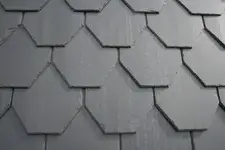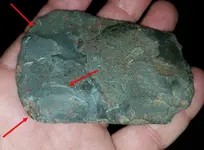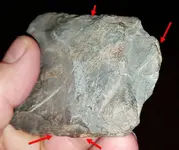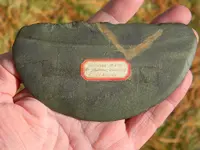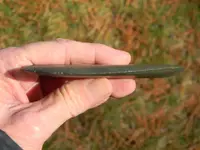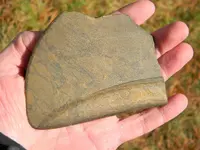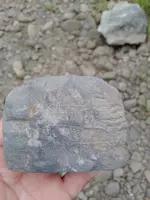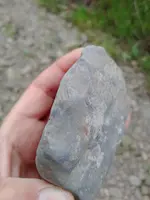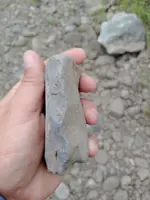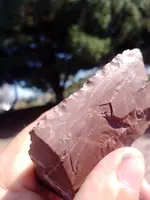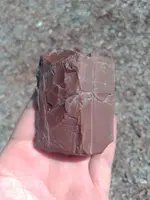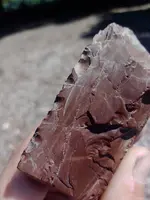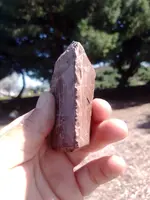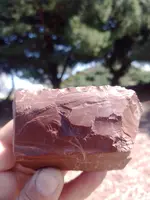I found this along a lakeshore in Southern New Brunswick while canoeing last summer. The closest thing I can find to compare to it are ground slate semi-lunar ulu knives, but the blade of what I've found is nearly flat.
The geometry reminds me of a chisel or single bevel broad axe.
It looks like the blade was pressure flaked along the entire edge on the beveled surface, while the back is nearly entirely flat. The upper surface is rounded and smoothed. Two of the corners have old breaks as you can see in the pictures. What on earth is it?
There are more pictures in the album here:
This appears to be a ground-stone adze.
Flat on bottom - haft is perpendicular to
Thank you all for your perspectives. What's funny is when I pulled this up out of the lake the consistent form made me think roof shingle as well, but this part of the lake is completely uninhabited and nearly completely surrounded by bog. This thing sat outside on my picnic table all winter because I didn't think it was anything. I brought it in for a closer look yesterday after reading about the slate tools found around the lake. I took some more pictures to show the edge. It is hard to convey in the pictures, but the upper surface is rounded and smoothed and if it weren't for the break at the corner it would have a very chisel-like form.
I agree that you would expect a slate tool like this to have a ground edge. What I think looks like pressure flaking is faint and worn looking, but I just can't think what I see could result from a natural break. Could it be worn from rolling around in the lake during the freeze and thaw cycle?
This is a ground stone adze. The
Arthur C. Parker
Chipped Stone. A multitude of stemmed, notched, leaf shape, triangular, serrated, and even unusual forms, with all varieties of drills and scrapers, covering a wide range of material. In the cases of the knives and blades, these are often of large size, but some types of arrow points are diminutive.
The groveless adze with triangular cross section.
Adzes. A celt with one side more flattened than the other may be regarded as an adz. This is easily determinable when the cutting blade is flattened on one side and beveled on the other. An interesting form of adz is that having beveled sides, that is to say with a cross-section an approximate oblong with the upper corners ground off. Most beveled adzes are made with great care, the plain surfaces are smooth and the entire blade is well polished.
I found this along a lakeshore in Southern New Brunswick while canoeing last summer. The closest thing I can find to compare to it are ground slate semi-lunar ulu knives, but the blade of what I've found is nearly flat.
The geometry reminds me of a chisel or single bevel broad axe.
It looks like the blade was pressure flaked along the entire edge on the beveled surface, while the back is nearly entirely flat. The upper surface is rounded and smoothed. Two of the corners have old breaks as you can see in the pictures. What on earth is it?
There are more pictures in the album here:
I found this along a lakeshore in Southern New Brunswick while canoeing last summer. The closest thing I can find to compare to it are ground slate semi-lunar ulu knives, but the blade of what I've found is nearly flat.
The geometry reminds me of a chisel or single bevel broad axe.
It looks like the blade was pressure flaked along the entire edge on the beveled surface, while the back is nearly entirely flat. The upper surface is rounded and smoothed. Two of the corners have old breaks as you can see in the pictures. What on earth is it?
There are more pictures in the album here:
This is not a flaked chert tool.
This is a ground stone argillite adze. Algonkian.
Once side is polished and the other flat. The flat side will support the protruding lip of the hafting handle. Opposite the worn head, is a pointed pin. These come in many different shapes and sizes
Is this from a historic area?
What State and region?
Are there any known historical narratives?
Are there other pieces found?
Where is the nearest body of water?
Petrography: Where is the nearest argillite quarry?
Dr. Arthur C. Parker says it's an adze:
From, ALGONKIAN OCCUPATION OF NEW YORK
Chipped Stone. A multitude of stemmed, notched, leaf shape, triangular, serrated, and even unusual forms, with all varieties of drills and scrapers, covering a wide range of material. In the cases of the knives and blades, these are often of large size.
The groveless adze with triangular cross section.
Adzes. A celt with one side more flattened than the other may be regarded as an adz. This is easily determinable when the cutting blade is flattened on one side and beveled on the other. An interesting form of adz is that having beveled sides, that is to say with a cross-section an approximate oblong with the upper corners ground off. Most beveled adzes are made with great care, the plain surfaces are smooth and the entire blade is well polished.













